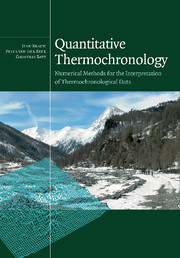Book contents
- Frontmatter
- Contents
- Preface
- 1 Introduction
- 2 Basics of thermochronology: from t–T paths to ages
- 3 Thermochronological systems
- 4 The general heat-transport equation
- 5 Thermal effects of exhumation
- 6 Steady-state two-dimensional heat transport
- 7 General transient solution – the three-dimensional problem
- 8 Inverse methods
- 9 Detrital thermochronology
- 10 Lateral advection of material
- 11 Isostatic response to denudation
- 12 The evolution of passive-margin escarpments
- 13 Thermochronology in active tectonic settings
- Appendix 1 Forward models of fission-track annealing
- Appendix 2 Fortran routines provided with this textbook
- Appendix 3 One-dimensional conductive equilibrium with heat production
- Appendix 4 One-dimensional conductive equilibrium with anomalous conductivity
- Appendix 5 One-dimensional transient conductive heat transport
- Appendix 6 Volume integrals in spherical coordinates
- Appendix 7 The complementary error function
- Appendix 8 Pecube user guide
- Appendix 9 Tutorial solutions
- References
- Index
9 - Detrital thermochronology
Published online by Cambridge University Press: 15 December 2009
- Frontmatter
- Contents
- Preface
- 1 Introduction
- 2 Basics of thermochronology: from t–T paths to ages
- 3 Thermochronological systems
- 4 The general heat-transport equation
- 5 Thermal effects of exhumation
- 6 Steady-state two-dimensional heat transport
- 7 General transient solution – the three-dimensional problem
- 8 Inverse methods
- 9 Detrital thermochronology
- 10 Lateral advection of material
- 11 Isostatic response to denudation
- 12 The evolution of passive-margin escarpments
- 13 Thermochronology in active tectonic settings
- Appendix 1 Forward models of fission-track annealing
- Appendix 2 Fortran routines provided with this textbook
- Appendix 3 One-dimensional conductive equilibrium with heat production
- Appendix 4 One-dimensional conductive equilibrium with anomalous conductivity
- Appendix 5 One-dimensional transient conductive heat transport
- Appendix 6 Volume integrals in spherical coordinates
- Appendix 7 The complementary error function
- Appendix 8 Pecube user guide
- Appendix 9 Tutorial solutions
- References
- Index
Summary
A relatively recent development in thermochronology is the analysis of samples from the erosional products of mountain belts, which is known as detrital thermochronology. The main advantage of detrital thermochronology over the more classical analysis of in situ samples is that the evolution of cooling and denudation rates through time can be monitored by analysing samples from sediments of different ages. Thus, detrital thermochronology provides a much longer ‘memory’ of denudation rates than does in situ thermochronology, especially in regions of high denudation rates and therefore young thermochronological ages. The gain in temporal range is, however, counterbalanced by a reduction in spatial resolution: it is not always clear what the source areas of the detrital samples were. In this chapter, we will discuss the basic approach of the detrital method and the quantitative interpretation of detrital thermochronological data in terms of the temporal evolution of source-area denudation rates and/or relief. We also consider the influence of post-depositional partial resetting on the interpretation of detrital data.
The basic approach
The long-term evolution of mountain belts is closely controlled by the interplay among tectonics, surface erosion and deposition (as discussed in detail in Chapter 13). Thermochronology provides us with insights into the exhumation history of rocks within the orogen and the use of multiple thermochronometers, or of multiple vertically separated samples, may help us to elucidate the evolution of the mountain-belt system within a thermal or spatial reference frame, respectively (cf. Section 1.2).
- Type
- Chapter
- Information
- Quantitative ThermochronologyNumerical Methods for the Interpretation of Thermochronological Data, pp. 131 - 150Publisher: Cambridge University PressPrint publication year: 2006
- 1
- Cited by



